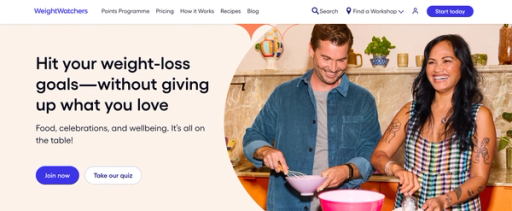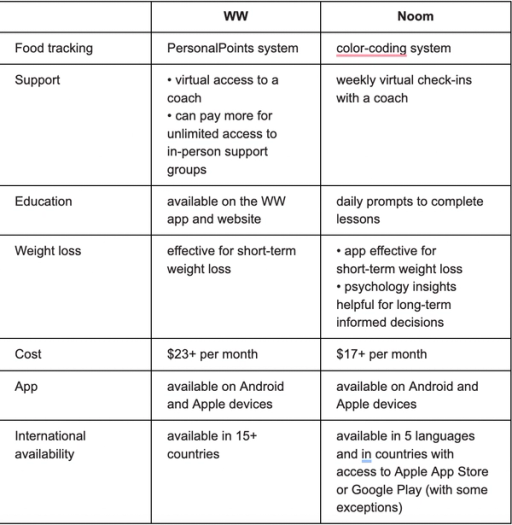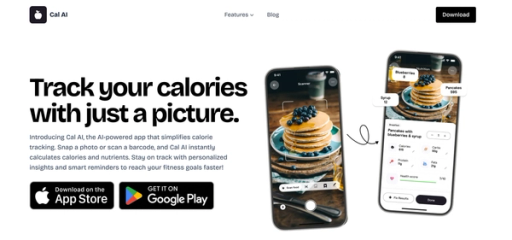
You want to lose weight but are unsure where to start. You’ve heard of Noom and Weight Watchers but don’t know how to choose between the two. Both programs seem to help users lose weight reliably. They have apps that allow you to track your progress, set goals, and stay motivated. Both programs even offer social support to help you stay on track. So how do you choose? This Noom vs Weight Watchers article will help you confidently select the weight loss program that best fits your lifestyle, preferences, and goals to achieve sustainable results.
A calorie tracker like Cal AI can help you achieve your objectives by offering an unbiased approach to calorie counting. This best app to track macros can help you visualize what Noom and Weight Watchers entail so you can make an informed decision before committing to a specific program.
Weight Watchers (WW) and Noom are two popular weight loss programs. And while they share some commonalities, they’re a lot different. You’ll likely see success with either program if consistent, but choosing the right one for you comes down to what you hope to get out of it.

Noom is a psychology-based weight loss program that uses cognitive behavioral therapy (CBT) techniques to enforce long-term lifestyle changes. The company takes the stance that weight gain and obesity are tied to unhealthy ingrained behaviors and that the key to long-term weight loss (or healthy weight maintenance) is changing these behaviors.
Instead of simply asking you to track food (although that’s a big part of the program), Noom has lots of educational components and daily lessons to help you identify your unhealthy habits and work to change them.
Noom coaches are also a big part of the program. When you sign up, you’ll be assigned to a coach who can provide tips and tricks to make things easier for you and/or offer encouragement to keep you on track.
Noom uses a color-coded system for food tracking that groups foods according to caloric and nutrient density. There are orange foods, yellow foods, and green foods. The more calorie-dense foods are categorized as orange foods (previously, they were classified as red foods, but the change likely came from the negative connotation associated with red). Green foods are low-calorie and nutrient-dense. Most green foods are:
Yellow foods are somewhere in the middle. In addition to food tracking and healthy eating, Noom emphasizes physical activity and water tracking. Noom is an app-only program, so you can only access your account via phone or tablet. It’s available both on Apple and Android devices.

Founded in 1963, Weight Watchers is one of the longest-running weight loss programs. While the program has adapted to the times, the general approach has remained unchanged. Weight Watchers uses a patented point system to help you reach your weight loss goals. The program is also designed to help with weight management.
You don’t count calories per se. Instead, foods are given a point value based on their nutrient and calorie density. After inputting your current stats and goals, you're given a daily points budget. Calorie-dense foods have more points, while no-calorie foods are tagged as “ZeroPoint Foods.” You track everything you eat to stay at (or under) your points budget.
There are some other nuances to consider, but the goal of Weight Watchers is to help you make healthier choices without any real food restrictions. There are no restrictions on macros like carbs or fat. Instead, these are higher-point foods, so you’ll naturally eat fewer when planning your daily points.
Weight Watchers also gives you access to a massive recipe database to easily track homemade foods, plus a barcode scanner for tracking packaged foods.
While food is the most significant focus of the program, you’ll also get a workout tracker and a vast community support group. Weight Watchers is known for its robust in-app and social communities. If connecting with peers is a priority for you, Weight Watchers has an edge here. You also have access to virtual coaches, which aren’t as central to the program as with Noom.

Noom and Weight Watchers help people lose weight. Both programs encourage weight loss through healthy eating and behavior change. While they take different approaches, Noom and Weight Watchers share some similarities. For instance, both programs:
While Noom and Weight Watchers have plenty in common, subtle differences affect how each program works and helps users reach their goals.
Noom’s whole philosophy is that overeating and weight gain are usually a result of learned behaviors or underlying traumas. Because of this, a large part of the program focuses on correcting these behaviors through cognitive behavioral techniques and nutrition education. Weight Watchers doesn’t take the same approach. This program focuses more on food tracking and paying attention to the types of food you eat. There’s not a significant focus on—or access to—nutrition education.
While both weight loss programs rely on food tracking, Weight Watchers is more structured than Noom. You’ll get a total number of daily points, and then you can build your diet around that point allotment. Noom gives you a calorie budget but doesn’t tell you how many calories are in the foods you’re eating. Instead, you just use colors to track the foods. This can make it more challenging to stay within your calorie goals.
Noom is considerably more expensive than Weight Watchers, especially if you want a shorter-term plan. If you choose the month-to-month option, you’ll pay $70 per month for Noom. The first month of Weight Watchers will be $43, then $23 per month after that. If you want to commit to a long-term subscription, the gap closes quite a bit. For a yearly plan, you’ll pay $17 per month for Noom (paid annually) and $10 per month for Weight Watchers.
Noom is strictly app-based, while Weight Watchers gives you options. There’s a WW app, or you can access your account through the website. If you live near a Weight Watchers clinic, you can also visit in person for check-ins and weigh-ins and attend live workshops and seminars (for an extra fee).
Both weight loss programs are subscribed, but the commitment options vary. Weight Watchers currently offers three subscription options: a monthly, three-month, and 10-month subscription.
Noom lets you choose monthly to yearly subscriptions and everything in between. You can do a two-month, three-month, four-month, five-month… to an 11-month auto-renewing plan. As mentioned, the price is heavily dependent on which plan you choose.
For Noom, the price varies widely. You’ll pay $70 per month if you choose the monthly plan. Committing to a full year costs $17 monthly, but you must pay for the entire year upfront.
Weight Watchers allows you a specific number of “Points” each day. Every food and drink has a corresponding Point value, with the healthiest foods being freebies with no points. Saturated fat and added sugar drive the Points value up, while fiber and protein drive it down.
In theory, if you consume the equivalent of your daily points (or below that number), you should lose weight, which you also record once a week on the platform. Upon joining, you’ll take an assessment of your:
These results will dictate the point budget you'll be working with and your list of ZeroPoint foods (or foods with 0 Points value, all of which are nutritional powerhouses that form the foundation for a healthy eating pattern).
These ZeroPoint foods generally include fruits and vegetables, eggs, lean proteins (chicken breasts, 99% lean ground turkey, most fish), and non-fat dairy. Drinks containing zero Points include things with no sugar or fat, such as:
There is also a diabetes-tailored plan available. Noom, much like Weight Watchers, aims to change your relationship with food using a slightly different approach. In addition to daily food logging, the Noom app provides motivation with daily “tasks” you’re asked to complete.
Most of these are short articles to read, usually about nutrition but often about psychological approaches—mindfulness, for instance—that reframe your outlook on dieting or life in general. Instead of assigning point values to individual foods as Weight Watchers does, Noom uses color codes in its program to classify foods into three categories based on caloric density.
Green foods are the ones that you should include most in your diet. These are low-caloric-density foods such as:
Red foods are the most calorie-dense and include nuts, cheese, and other items that should be consumed sparingly. Yellow foods like chicken, eggs, and avocados fall in the middle and should be consumed in moderation.
The idea is that you can eat a larger quantity of food that contains fewer calories per ounce (say, 100 calories of spinach or an entire pound of salad greens) than the same amount of higher-caloric-density foods (like 100 calories of Skittles or a measly 25 of the tiny candies). As the lower caloric-density foods tend to contain more water and fiber, those foods will likely also keep you satiated for longer. And if you feel less hungry, you’ll be less likely to overindulge.
It comes with the territory of weight loss that if you eat more than you should, you won’t lose weight, or you may even gain. Both programs have proven track records, but each program is what you make of it. You won't see results if you aren’t disciplined in your food decisions and tracking.
Nevertheless, both Weight Watchers and Noom make success more feasible by allowing for some flexibility, which many reviewers say is the key to making them work.
You won't see results if you aren’t disciplined in your food decisions and tracking. With Weight Watchers, you’re given weekly points, or “weeklies,” on top of your daily points. These can give you the freedom to indulge. If you review your daily point budget on any given day, points are taken from your weekly points. If you don’t reach your daily max, up to 4 points will roll over into your weekly point bank.
Save up those weeklies for a decadent treat on the weekend, use them sparingly throughout the week, or not at all. It’s your choice, but flexibility means never giving up your favorite foods entirely. Noom’s color classifications are more guidelines than rules.
If you go over your red food allotment for the day but stay within your calorie range—or even exceed your daily calorie count—there are no repercussions beyond seeing the bar chart exceed your target ceiling. And that’s enough: If you know that you're exceeding your totals day after day, you’re only cheating yourself in the long run.
Physical activity is one of the four core pillars at Weight Watchers, besides food, mindset, and sleep. Members can track how many points they’ve added from activity, and you can even expand your daily budget by working out. A point will be added to your weekly Points Budget for every point added to the activity.
High-intensity or strength workouts will add the most points, but all movement counts. The Points you add are calculated by the intensity of your activity and your metabolic rate. You can even link your Weight Watchers app to your phone or fitness tracker, and members can track their programs within the app, such as several steps a day or minutes of activity.
In addition to hundreds of workouts on the Weight Watchers app, being a member gives you free access to:
Noom has a paid add-on option for a custom workout plan. Beyond that, the app encourages you to exercise daily, whether walking or taking a yoga or spin class.
There is a daily box to check whether or not you've exercised. You can sync Noom with your phone’s health data (e.g., Apple Health or Google Fit), a Fitbit, or other fitness trackers so that you don't manually enter fitness information. If you do that, Noom will set a daily step goal that varies based on your history. It starts at 2,000 steps per day and goes up as long as you complete that day's goal. If you miss a day, it regresses.
Weight Watchers takes a more holistic approach to weight loss by looking at food and other contributing factors to your health, such as your mindset and sleep, and offers tools to help you. There’s an activity dashboard that enables you to move more and find workouts that you enjoy. You can listen to 5-minute audio lessons from expert coaches to:
And some sleep tools aim to help you get to bed on time and enjoy a better night’s sleep based on science-backed strategies. And the link between good sleep and maintaining a healthy weight is paramount.
The Noom app refreshes every day with about eight "tasks" that you are asked to complete. Most of the tasks are short articles to read, usually about nutrition, but often about psychological approaches—mindfulness, for instance—that reframe your outlook on dieting or life. Users complete the program with:
There’s even an entire program dedicated to improving your mindset called the Noom Healthy Mind program, which empowers participants better to manage their daily stress and anxiety in a fun, engaging way.

Noom is an excellent choice for exploring the psychological factors behind weight loss. "It addresses the psychology behind why we eat and the food choices that we make," says Abby Langer, RD, the owner of Abby Langer Nutrition and author of Good Food, Bad Diet. "And for me, that's of the utmost importance when it comes to having a shot at a sustainable weight loss plan."
If you want to change your relationship with food while losing weight, Noom may be the best option.
Weight Watchers has a long-standing reputation and a supportive community, which can be helpful for some people. "They're constantly updating their algorithm and offerings based on what they know about their community," says nutritionist Kristen Cassetty, RD. Weight Watchers may be better for you if you want structure and support.
You can also look at the science. According to one study with Noom, of 15,000 people, only 24 percent kept the weight off for a year. And with WW, of 1,269 participants, 64 percent of the pounds lost in a 52-week program was maintained at two years, another study found.
"This study may have seen results, but I'd be interested to see if these patients have disordered eating or are engaging in unhealthy eating practices," notes Ehsani.
Regardless of which program you go for, Cassetty says it's essential to be flexible with yourself when you've had a so-called slip-up—say, by eating too many red foods or exceeding your SmartPoint limit.
"We don't want to demoralize food," Cassetty says. "We just have to learn how to enjoy it more healthfully." She emphasizes that this can be done in either program with care and self-forgiveness.

Cal AI transforms calorie tracking with cutting-edge AI technology. Just snap a photo of your meal, and we'll do the rest.
Our app combines your phone's depth sensor with advanced AI models to:
With 90% accuracy on visible foods and multiple tracking options like:
We've made nutrition tracking effortless. Whether you're scanning a full meal or a quick snack, Cal AI
Our AI learns from your feedback to improve accuracy. It includes personalized insights and smart reminders to keep you on track. Cal AI makes achieving your fitness goals simpler than ever.
Track your calories with your camera using Cal AI's calorie tracker today!